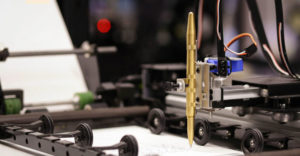
IBM on Wednesday unveiled a new category of server designed specifically for cloud computing and Web 2.0 applications.
The iDataPlex system builds upon IBM’s blade server background and more than doubles the number of systems that can run in a single IBM rack. It also uses 40 percent less power while quintupling the amount of computing that can be done.
The iDataPlex can be outfitted with a liquid-cooled wall to eliminate the need for air conditioning, and it uses industry-standard components including Linux and cluster-management technology xCat to reduce its cost.
The machine will be available in the United States and Canada in June, and by the end of the year in the rest of the world. It is shipped with customized configuration for each customer; pricing depends on configuration.
Greener Clouds
Companies that operate massive scale-out data centers spend between 10 and 30 times more on energy costs per square foot than a typical office building, according to IBM, and a big part of that is for the air conditioning to cool the hundreds of thousands of servers they typically include.
The highly efficient iDataPlex, on the other hand, will help clients move to new enterprise data centers by focusing on best practices around virtualization, green IT, service management and cloud computing, IBM said.
“With iDataPlex, IBM is making Web 2.0-style computing more efficient and commercializing it for Internet companies and other high performance segments like financial services and research,” said Bill Zeitler, senior vice president of IBM Systems and Technology Group. “iDataPlex can provide a foundation that companies can build on to provide improved services to Web users around the world.”
Compute Density
Indeed, “the thing that was most compelling to me is the attention they paid to compute density, and also the power efficiency they got when they redesigned everything,” Susan Eustis, president of WinterGreen Research, told TechNewsWorld.
“When you look at what Google and other Web 2.0 companies are doing, it’s very clear that the quantity of information is doubling every seven months — and that pace is accelerating as well,” Eustis explained. “In that context, compute density becomes very important.”
The functionality of Web 2.0 applications — and the associated advertising dollars — depend on high processing capabilities, Eustis noted.
In the competitive landscape, “I think IBM will be dominant until the others catch up,” she said.
‘Radically Innovative’
Each iDataPlex system can be made and shipped from the factory fully integrated and ready to run. Among the early clients that have adopted or are actively considering the iDataPlex are Yahoo and Texas Tech University, IBM said.
“I think the conventional wisdom about industry standard servers is that they are all the same under the covers,” Charles King, president and principal analyst with Pund-IT, told TechNewsWorld. “If you go from one x86 rack server to the next, there are some differences, but the end performance and power consumption are roughly the same.”
What the iDataPlex proves, on the other hand, is that “it’s possible to take something most people think they know everything about and fundamentally rethink it and come up with something radically different and radically innovative,” King said.
Like a Car’s Radiator
IBM’s efforts to reduce power consumption, for example, go far beyond what others have done, King said.
“People have been talking about green data center issues for a long time, and there is a certain amount of power consumption that can be carved out of the actual server itself, such as by removing redundant power supplies and fans,” King explained.
In addition to that, however, IBM also redesigned the server chassis and rack to reduce power by about 40 percent, he noted.
IBM’s rear-door heat exchanger, or liquid cooling system, functions much like a car’s radiator and dissipates heat through cooling fins, King added.
It’s the combination of those innovations that eliminates the need for data-center air conditioning, he said.
Removing Complexity
The fact that the machines are custom-designed to support specific types of applications or workloads is also innovative, King noted.
“What’s cool about what IBM is doing is that the racks are fully built and assembled at the factory, fully tested and integrated at the factory, then shipped whole,” he explained. “By managing complexity at the factory, they’re removing complexity for customers.”
Shipping the devices whole also eliminates a “huge amount” of packing material, he noted.
In short, King concluded, “I don’t think it’s an overestimation to say that this is one of the coolest — literally — and greenest data center products available today.”





















































